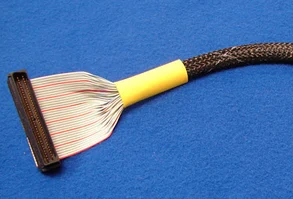Flex and ribbon cables are replacing round cables in various assemblies thanks to higher performance, improved efficiency, and a more extensive range of applications. Here’s how to choose the right type for your cable assemblies.
What Is a Ribbon Cable?
 Also known as multi-wire planar cable, a ribbon cable consists of multiple wires running parallel to each other on a flat plane. The flat and flexible cables are often used for internal peripherals in computers, such as hard drives and CD drives. They’re also found in printers, robotics, circuit boards, industrial controls, and more.
Also known as multi-wire planar cable, a ribbon cable consists of multiple wires running parallel to each other on a flat plane. The flat and flexible cables are often used for internal peripherals in computers, such as hard drives and CD drives. They’re also found in printers, robotics, circuit boards, industrial controls, and more.
Ribbon cables are very flexible and offer many advantages over rigid cable assemblies. Thanks to their versatility, ribbon cables can fulfill various requirements simultaneously to reduce material usage and lower costs.
What Is a Flex Cable?

Flex cables offer various benefits, such as space-saving and resistance to electromagnetic interference (EMI) and radio frequency interference (RFI). The configuration minimizes issues related to wire coupling, while the uniform shape helps simplify cable management.
Applications For Flex and Ribbon Cables
Ribbon cables’ flexibility and space-saving advantage make them an ideal choice for a wide range of uses. They’re found in mission-critical applications, from military equipment to medical devices, thanks to their long lifespan, ability to reduce EMI and RFI, and a high tolerance for extreme temperatures. When used with insulation-displacement contact (IDC) connectors, ribbon cables are great for wire-to-board applications.
Flex cables are even more versatile than ribbon cables. Besides being lighter in weight and smaller in volume, they’re more efficient at heat dissipation, offer better signal transmission, and deliver a higher level of performance. Flex cables are used in advanced electronic devices, including motherboards, plotters, and LCD appliances.
Connectors and Terminations For Flex and Ribbon Cables
You must use the appropriate connectors and terminations for each specific application to optimize these cable assemblies’ abilities to transmit the maximum amounts of data, electricity, or signals. Some commonly used connectors include d-subminiature (d-sub), socket, dips, and card edge.
Additionally, a flat ribbon cable assembly has a rigid spacing plan, which allows for mass termination with IDC connectors to help you save time and money while improving overall efficiency.
How Rigid vs. Flexible PCBs Influence Cable Assemblies
Printed circuit boards (PCBs) are often used in conjunction with flex and ribbon cable assemblies. They’re critical for sending data, signals, and/or power through the cables.
A rigid PCB is cheaper to manufacture. However, you’ll need to use various connectors in the cable assemblies, so the final cost often comes out higher. A rigid-flex PCB is more costly to produce but typically involves simpler assembly and fewer components that can fail in the long run.
Meanwhile, flexible printed circuit (FPC) has evolved significantly to deliver a high level of durability and reliability for various applications, including cell phones, LCD televisions, antennas, hearing aids, calculators, cameras, printers, and laptops. They’re also widely used in the aviation industry.
Finding the Right Components For Your Cable Assemblies
From cables and connectors to circuit boards, you must consider different components when designing a cable assembly. The right solution must balance cost, ease of production, durability, and performance to meet your requirements.
We offer custom cable assemblies for any configuration or requirement. Learn more about our extensive capabilities and see how we can help you meet the specifications of your projects.


